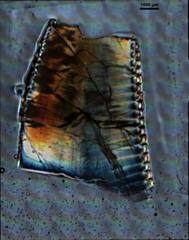Project 3838: M. R. Whitney, A. R. LeBlanc, A. R. Reynolds, K. S. Brink. 2020. Convergent dental adaptations in the serrations of hypercarnivorous synapsids and dinosaurs. Biology Letters. 16 (12):20200750.
Abstract
Theropod dinosaurs are well known for having a ziphodont dentition: serrated, blade-shaped teeth that they used for cutting through prey. Serrations along the carinae of theropod teeth are composed of true denti- cles, a complex arrangement of dentine, enamel, and interdental folds. This structure would have supported individual denticles and dissipated the stresses associated with feeding. These particular serrations were pre- viously thought to be unique to theropod dinosaurs and some other archosaurs. Here, we identify the same denticles and interdental folds form- ing the cutting edges in the teeth of a Permian gorgonopsian synapsid, extending the temporal and phylogenetic distribution of this dental mor- phology. This remarkable instance of convergence not only represents the earliest record of this adaptation to hypercarnivory but also demonstrates that the first iteration of this feature appeared in non-mammalian synapsids. Comparisons of tooth serrations in gorgonopsians with those of earlier synapsids and hypercarnivorous mammals reveal some gorgonopsians acquired a complex tissue arrangement that differed from other synapsids.
Read the article »
Article DOI: 10.1098/rsbl.2020.0750
Project DOI: 10.7934/P3838, http://dx.doi.org/10.7934/P3838
| This project contains |
|---|
Download Project SDD File |
Currently Viewing:
MorphoBank Project 3838
MorphoBank Project 3838
- Creation Date:
20 October 2020 - Publication Date:
12 January 2021
This research
supported by
Authors' Institutions ![]()
- Harvard University

